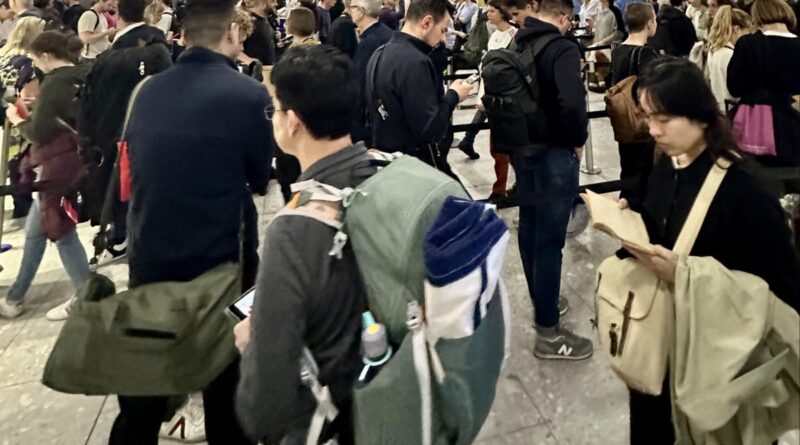Airport chaos as e-gates fail again – what went wrong?
Tens of thousands of airline passengers arriving at airports across the UK faced waits of several hours last night after another collapse of the e-gates system that automatically checks passports. The IT failure took over four hours to fix, during which time large queues built up.
The latest nationwide failure of the e-gates system started at 7.44pm on Tuesday evening. The Home Office says “a large-scale contingency response” was brought in within six minutes – basically, everyone had to have their passport checked manually.
With planes arriving every few minutes at Heathrow, Gatwick, Manchester, Stansted, Luton, Edinburgh and other airports, queues quickly built up.
At Heathrow, the pressure on space in the terminal meant that passengers were kept on planes, typically for half an hour.
Many people were waiting in line for two hours or more, and inevitably public transport shut down for the night – leaving many people to try to find taxis home or get hotels at the airports.
The system was restored soon after midnight but the backlog took time to clear.
Simon Calder, travel correspondent at The Independent, met some passengers at Heathrow as they emerged from International Arrivals in the early hours of the morning.
What did passengers say?
Fleur Lauriot flew from Paris Charles de Gaulle to Heathrow to visit her family. “At the start of the queue, there was a kind of ‘every man for themselves’ attitude. People were queue-jumping, which wasn’t good,” she said.
“We were queuing for what felt an eternity. But you know, as Brits, we love to queue.”
Mariella touched down at Heathrow from Athens at 8.30pm and eventually emerged from International Arrivals shortly before 11pm. She told The Independent: “It was just crazy for two and a half hours. People lost their connection flights and had to go to hotels to sleep for the night.”
Shenaz, a Londoner, arrived from Lisbon ahead of schedule at 9.10pm. She finally cleared passport control two hours later. “British Airways staff were very good,” she said.
“The airport staff were good. It’s a computer glitch. You blame the higher authorities.”
Across at Stansted, Jenny Barber said: “It was chaotic. No communication, no direction once you got to gates, hardly any staff. Appalling.”
How do the e-gates work – and why are they so important?
Almost 300 e-gates are installed at airports across the UK, as well as at Eurostar rail terminals in mainland Europe. They are at the heart of the UK Border Force operation. They verify that the passport is valid and belongs to the traveller.
A large majority of inbound passengers can use them: anyone aged 10 or over from the UK, the European Union, the wider Schengen area, North America, Australasia, Singapore, South Korea and Japan.
You put the photo page of your passport on the scanner and look into the camera. The system checks that it is a valid passport and that you are the owner. The gates open and you are typically through in about 15 seconds flat from the start of the process.
Because most arriving travellers are processed automatically, it allows passport control officers to focus on individuals of interest from other parts of the world.
UK Border Force staffing rosters are made on the assumption that e-gates will be taking care of, typically, 75 per cent of passengers.
This isn’t the first failure of this kind…
The worst collapse of the e-gates was over the late May bank holiday weekend in 2023, when a software upgrade went awry.
Within the past two weeks, another relatively brief e-gates failure in the late afternoon led to queues of up to two hours at Edinburgh, Manchester, Bristol and other airports.
Do we have any idea what caused it?
No. All that a Home Office spokesperson would say on the subject is: ”At no point was border security compromised and there is no indication of malicious cyber activity.”
Are flights back to normal?
Yes. The fear at Heathrow was that the system wouldn’t be fixed in time for the first wave of arrivals. Each morning, around 10,000 passengers arrive every hour at the UK’s biggest airport.
Had the airlines been ordered to keep people on planes to avoid overcrowding, departing passengers would have been unable to board those planes on schedule, which would in turn block gates and potentially lead to cancellations. Many passengers transferring to domestic flights would have missed connections.
Fortunately, the problem was solved with several hours to spare. The Home Office spokesperson said: “E-gates at UK airports came back online shortly after midnight. We apologise to travellers caught up in disruption and thank our partners, including airlines for their co-operation and support.”
Are passengers entitled to any compensation?
No, because this was clearly beyond the airlines’ control. Travellers who incurred extra costs for taxis or airport hotels may possibly be able to claim on travel insurance.
What will be done to ensure there is no repeat?
It is not clear but senior figures are demanding action. Julia Lo Bue-Said, chief executive of the Advantage Travel Partnership, said: “If we are to rely heavily on technology, there needs to be sufficient investment in the technologies used in travel to ensure that these systems run smoothly and robust contingency plans in place to avoid any unnecessary disruption to travellers.”
Lord Foster of Bath, chair of the Lords justice and home affairs committee, said: “The nationwide failure of e-gates is deeply concerning.
“Technology invariably fails but the e-gates systems have experienced a number of problems recently. Border Force staff must be equipped and trained to deal with such situations when they arise. Minimising disruption to passengers is important but the security of the borders must remain the top priority.
“The government’s ambition is to have ‘the most effective border in the world’. In order to achieve this ambition, the government must get the fundamentals right – and it must be prepared to learn the appropriate lessons when things go wrong.”
The direction of travel is towards more automation, with plans to introduce “passportless” facial recognition. Phil Douglas, director-general of the UK Border Force, is aiming for “much more frictionless facial recognition than we currently do”.
The aim is to upgrade the current e-gates system so that arriving passengers can keep their passports in their pockets and be admitted to the UK simply by looking into a camera.




